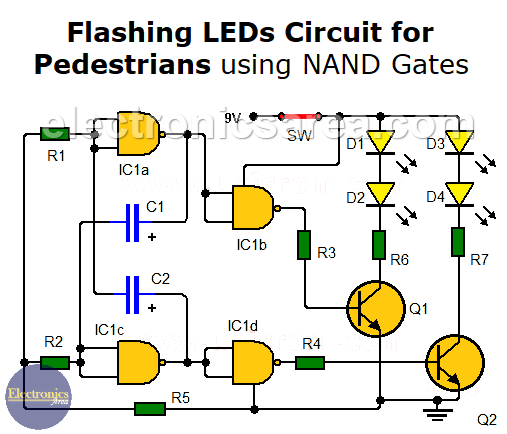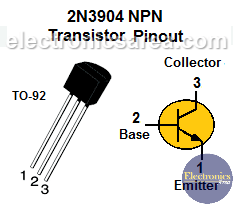Home / Circuits / LED Circuits /
Flashing LEDs Circuit for Pedestrians
This simple Flashing LEDs Circuit for pedestrians is very useful for people who like to walk at night. Two groups of high intensity white LEDs light alternately, being easily visible at night.
Some people use phosphorescent colors in their clothing, in order to be more visible at night and avoid accidents due to lack of visibility. This normally happens on streets with little or no light.
This circuit further improves the visibility of pedestrians. The device can be placed on any part of the body, such as an arm, a leg, etc.
How does the flashing LEDs circuit for pedestrians work?
The circuit consists of two parts:
1 – The first part is an astable multivibrator made with two 2-input NAND gates. The two NAND gate outputs of this multivibrator are applied to two other NAND gates that function as inverting gates (NOT gates). These last gates are not necessary for the circuit to work properly, but they are used so that all the gates of the integrated circuit are working.
2 – In the second part, each output of the gates mentioned above is applied to a transistor through a resistor. These transistors constantly go from the cutoff region to the saturation region, turning the two groups of LEDs on and off.
The oscillation frequency of the astable multivibrator can be modified by changing the values of the resistors R1 and R2 and the values of the electrolytic capacitors C1 and C2.
If you want to increase the intensity of the light, you can change the groups of 2 LEDs in series to groups of 3 LEDs in series, removing the resistors R6 and R7. The circuit is powered by a 9 volt battery for easy transport.
Keep in mind that if 3 LEDs are used instead of 2, the battery should not have a voltage lower than 9 volts, because the LEDs may not turn on or give very low light.
You may be interested in a circuit of flashing lights for cyclists, very useful if you want to go out at night.
List of components for the flashing LEDs circuit for pedestrian
- 1 x 4011B IC (four 2-input NAND gate) (IC1)
- 2 x 2N3904 NPN bipolar transistors (Q1, Q2)
- 4 High efficiency white LEDs (D1, D2, D3, D4)
- 2 x 470K, 1/4W resistors (R1, R2)
- 2 x 47K, 1/4W resistors (R3, R4)
- 1 x 1K, 1/4W resistor (R5)
- 2 x 330 ohms, 1/4W resistors (R6, R7)
- 2 x 4.7uF / 25V or more electrolytic capacitors (C1, C2)
- 1 switch (SW1)
More LED circuits
- Emergency lighting circuit with LEDs
- Automatic night light circuit with one LED (PCB)
- Bike flashing LED lights circuit
- Flashing LEDs circuit for pedestrians
- Two-way traffic light circuit
- LED sequencer using 4017 decade Counter (LED Chaser)
- Light push button circuit with time delay
- Energy-saving flashing pilot light
- LED connected to 120/240 VAC
- Police style strobe light circuit







